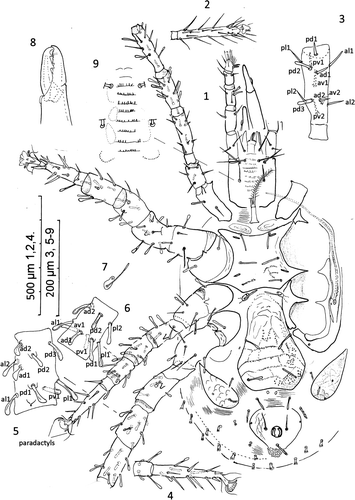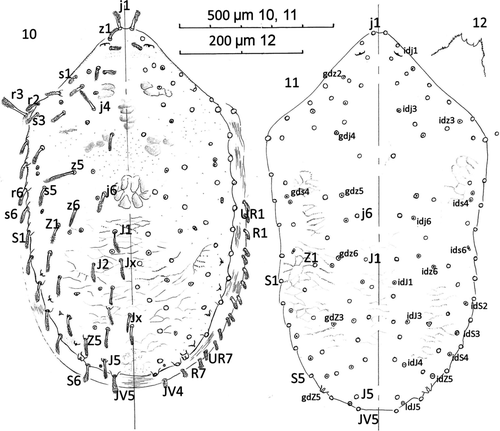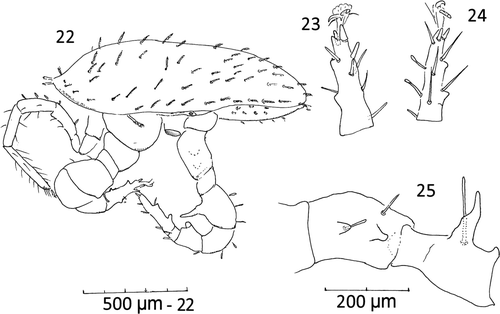Figures & data
Figures. 1–9 Ayersacarus woodi sp. n. 1, female venter; 2, ventral view of tarsus I; 3, dorsal view left femur leg I; 4, tarsus IV, ventral view; 5, genua IV, dorsal view; 6, left tibia III, dorsal view showing shape of the 9 setae; 7, metasternal shield; 8, chelicerae, medial view; 9, another paratype female with 8 rows of deutosternal denticles.

Figures 10–12 Ayersacarus woodi sp. n. 10, Female; dorsal shield; 11, large male dorsal shield; 12, male epistome.

Figures. 13–21 Ayersacarus woodi sp. n. Male. 13, ventral view; 14, tibia I lateral view of alveoli positions; 15, subcapitulum, ventral view; 16, chelicerae and spermatodactyl; 17, distal tarsus IV spines and pre-tarsus paradactyls; 18, pre-tarsus and distal tarsal III spines, ventral view; 19, genua [2,2/1,2/1,1], tibia [1,2/1,2/1,2] and basi-tarsus leg III, ventral view; 20, inset of leg apophyses and companion setae; 21, pre-tarsus and distal tarsus of leg II, ventral view.
![Figures. 13–21 Ayersacarus woodi sp. n. Male. 13, ventral view; 14, tibia I lateral view of alveoli positions; 15, subcapitulum, ventral view; 16, chelicerae and spermatodactyl; 17, distal tarsus IV spines and pre-tarsus paradactyls; 18, pre-tarsus and distal tarsal III spines, ventral view; 19, genua [2,2/1,2/1,1], tibia [1,2/1,2/1,2] and basi-tarsus leg III, ventral view; 20, inset of leg apophyses and companion setae; 21, pre-tarsus and distal tarsus of leg II, ventral view.](/cms/asset/d11459e1-e9ec-4ee3-91ea-022013daa900/tnzz_a_525746_o_f0003g.gif)
Figures 22–25 Male, large. 22, idiosomal, lateral view showing leg apophyses; (leg III and many setae removed); 23, tarsus II lateral view showing apophyses (many setae removed); 24, tarsus IV showing apophyses, medial view; 25, trochanter and femur IV ( most setae removed) medial view.

Figures. 26–34 Ayersacarus woodi sp. n. compared with females of two sub-Antarctic species. 26, Ayersacarus woodi sp. n. dorsal shield setae (open circles) and poriods (dotted circles) compared to 27, A. plumapilus holotype and 28, A. gressitti holotype; 29, Ayersacarus woodi sp. n. post-ventral morphology; 30, A. plumapilus post-ventral morphology; 31, A. gressitti post-ventral morphology; 32, Ayersacarus woodi sp. n. epistome of two female paratypes; 33, A. plumapilus, holotype epistome; 34, A. gressitti, holotype epistome. Note: for Figs. 29–31, distances between shields not diagnostic as the shields are set in soft striate cuticle. The shield shapes and sizes are diagnostic.

Figures. 35–37 Comparison of setal alveoli insertion patterns to tarsus IV. 35, A. plumapilus holotype, anterolateral view; 36, A. gressitti holotype dorsal view; 37, A. woodi sp. n. holotype dorsal view. d. lyr=mid-dorsal lyrifissure. See text for setal nomenclature.

Figure 38 Isotope data for Ayersacarus woodi sp. n. and data for other components of the terrestrial system occupied by Westland petrels; terrestrial C sources are shown in the dashed box, and marine C sources are shown in the solid box. Isotopic values for fresh Westland petrel guano are from Hawke (Citation2005); data for terrestrial amphipods (Talitridae), matai (Prumnopitys taxifolia) fruit and Westland petrel feathers are from Hawke & Holdaway (Citation2005). Error bars (where shown) are±1SD; some are smaller than symbol size.
